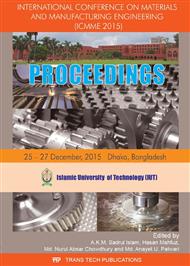p.111
p.117
p.123
p.129
p.134
p.140
p.146
p.152
p.158
Physical and Mechanical Properties of Chemically Treated Jute Fiber Reinforced MAgPP Green Composites
Abstract:
Natural fibers are biodegradable, non toxic, recyclable, energy efficient and eco-friendly, which reduce the issue of waste disposal as seen in the case of synthetic fibers. Jute is the cheapest lignocellulosic long vegetable bast fiber and abundantly available in South Asia, especially in Bangladesh. It offers a number of benefits as reinforcement in synthetic polymers. In the present study, jute fiber was chemically treated in order to make it fire, rot and water retardant. Jute fiber reinforced green composites were manufactured using preheated chopped jute fiber and maleic anhydrate grafted polypropylene in the hot press machine at a temperature of 180°C and a pressure of 40 kN. Both raw and chemically treated jute fibers at three levels of fiber loading (20, 25 and 30 wt%) were utilized during composite manufacturing. Micro-structural analysis and mechanical testing of the manufactured green composites were subsequently carried out. Chemically treated jute fiber composites showed an improvement in mechanical properties as compared to the maleic anhydrate grafted polypropylene. The impact property was not significantly affected by chemical treatment. At room temperature water uptake increased with fiber weight fraction, while water retardant jute fiber composites absorbed more water as compared to the other composites. The rot retardant treated jute fiber composites had the best set of mechanical properties among all manufactured composites. SEM observation of the fracture surface clearly showed that control and rot retardant jute fiber reinforced green composites had more fiber pull out as compared to fire retardant and water retardant jute fiber reinforced green composites. This indicates better adhesion between the matrix and fiber in case of the fire retardant and water retardant green composites. Chemically treated jute fiber reinforced green composites could be popular as a substitute of plastic in house hold sectors as a moderate load bearing component.
Info:
Periodical:
Pages:
134-139
Citation:
Online since:
December 2016
Authors:
Price:
Сopyright:
© 2017 Trans Tech Publications Ltd. All Rights Reserved
Share:
Citation:


